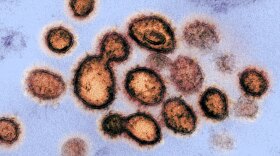It has been three weeks since Colorado lifted its stay-at-home order and moved into the less restrictive safer-at-home phase of its response to the coronavirus. How well are Coloradans following social distancing practices? And what do the models say about future cases of COVID-19 in our state?
Dr. Jonathan Samet, dean of the Colorado School of Public Health, joined KUNC's Colorado Edition to answer these questions.
Interview Highlights
These interview highlights have been lightly edited for length and clarity
Erin O’Toole: Overall, how is the safer-at-home period going? What do we know about how Coloradans have been doing at social distancing since the order went into effect?
Dr. Jonathan Samet: I’m going to answer from several perspectives here. The first is that it takes a while for us to learn what happens after we make the change in social distancing. Going from safe-at-home, to shelter-in-place at home, to safer-at-home. It’s about two weeks between becoming infected and being hospitalized. And hospitalization is one of the key indicators we are tracking. We are right now on the cusp of getting a more certain understanding than has been possible about where we are. We’re watching very, very closely. The good news is that hospitalizations have continued to drop, as have deaths, but the next couple weeks, we’ll get a far better signal about what has happened consequent to April 27.
Given what we know about current social distancing, when will the peak number of cases be? Has it already happened?
For now, we’ve experienced a peak and that goes back several weeks ago. The goal now is to avoid having another peak. If we maintain a high level of social distance, we continue to flatten the curve, an expression that has become well known to everyone, and the peak would be much lower than it would be without the social distancing, and that comes around in late August or September, depending on what happens.
We hear about a resurgence of cases in some other countries. Is there a projected timeline for a second wave here?
It depends on how much social distancing we maintain. The more there is, the later the peak will be, so if you can imagine, if we just sort of went back to “normal,” pre-COVID-19 we would probably potentially see a steep rise that might happen over the next few weeks. If we maintain the needed levels of social distancing, and we’re trying to figure out exactly what needed is, then that peak comes much later and it’s of course much much lower.
There are some key points along here, for example looking at schools opening in August perhaps, what would the implications of opening schools, or of making other changes over time. So the models help, and then reality helps, and we have to bring the two together, then of course we have this mobility data which is also very helpful.
Something that a lot of us are wondering now, is how will all of this end? When will life be able to go back to normal?
There’s two possibilities, well, maybe three.
One would be that we have a vaccine that works. And that of course, many different groups are working on developing a vaccine. I will say, I think we have to acknowledge, that once we have a vaccine, we still have to immunize the world, which is going to be no small task.
Another would be that enough people become infected so we have so-called herd immunity. That is that the virus can’t propagate because it can’t find enough susceptible people to sustain an epidemic. Right now, perhaps 2% to 3% of people in Colorado have been infected. If we need to get to 80%, we have a long way to go to get to herd immunity. So that would be digging in for the longer run while awaiting a vaccine, and then the question would be how is the epidemic managed, how do we maintain enough social distancing, while still having a solid economy to get to that 80% mark?
The third possibility, and one again, people are working on, would be to have effective therapies. There are many clinical trials going on of different agents. I will say, with the exception particularly of HIV/AIDS and a few other viruses, we have not done very well in developing potent anti-viral agents. Some have been tried — it seems like there’s one, remdesivir, that may moderate the severity of the infection, but we have a long way to go I think on the therapeutic side as well.
I’m afraid, hopefully we’ll make a transition back to a pre-COVID-19 world, but I think it will be a longer transition than any of us want.
This conversation is part of KUNC’s Colorado Edition for May 18. You can find the full show here.




